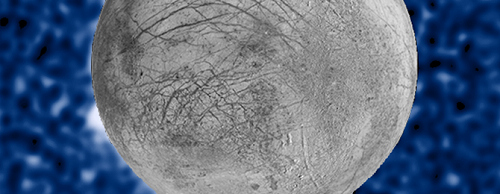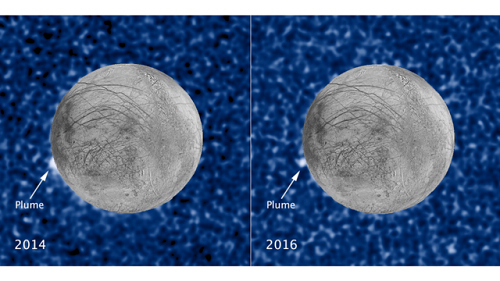Hubble Spots Possible Venting Activity on Europa
Best Evidence Yet for Reoccurring Water Vapor Plumes Erupting from Jupiter’s Moon

When Galileo discovered Jupiter's moon Europa in 1610, along with three other satellites whirling around the giant planet, he could have barely imagined it was such a world of wonder.
This revelation didn't happen until 1979, when NASA's Voyager 1 and 2 flew by Jupiter and found evidence that Europa's interior, encapsulated under a crust of ice, has been kept warm over billions of years. The warmer temperature is due to gravitational tidal forces that flex the moon's interior — like squeezing a rubber ball — keeping it warm. At the time, one mission scientist even speculated that the Voyagers might catch a snapshot of geysers on Europa.
Such activity turned out to be so elusive that astronomers had to wait over three decades for the peering eye of Hubble to monitor the moon for signs of venting activity. A newly discovered plume seen towering 62 miles above the surface in 2016 is at precisely the same location as a similar plume seen on the moon two years earlier by Hubble. These observations bolster evidence that the plumes are a real phenomenon, flaring up intermittently in the same region on the satellite.
The location of the plumes corresponds to the position of an unusually warm spot on the moon's icy crust, as measured in the late 1990s by NASA's Galileo spacecraft. Researchers speculate that this might be circumstantial evidence for material venting from the moon's subsurface. The material could be associated with the global ocean that is believed to be present beneath the frozen crust. The plumes offer an opportunity to sample what might be in the ocean, in the search for life on that distant moon.

Recent observations of Jupiter's icy moon Europa by NASA's Hubble Space Telescope have uncovered a probable plume of material erupting from the moon's surface at precisely the same location as a similar apparent plume seen two years earlier by Hubble. These images bolster evidence that the plumes are a real phenomenon, flaring up intermittently in the same region on the satellite.
In the most recent observation — Feb. 22, 2016 — Hubble's Space Telescope Imaging Spectrograph (STIS) uncovered a dark patch, silhouetted against Jupiter and protruding slightly off the surface at Europa's equatorial region. The dark feature is not only in the same location but is also similar in appearance to the one seen in a previous STIS study of Europa, taken March 17, 2014.
For both the 2016 and 2014 observations, Sparks and his team used the same transit technique to uncover the plumes in ultraviolet light. As Europa passes in front of Jupiter, any atmospheric features around the edge of the moon block some of Jupiter's light, allowing STIS to see those features in silhouette.
The plumes correspond to the location of an unusually warm spot on the moon's icy crust, seen in the late 1990s by NASA's Galileo spacecraft. Researchers speculate that this might be circumstantial evidence for water erupting from the moon's subsurface. Such a "location of interest" may be a site where material dredged up from beneath Europa's surface could be analyzed for habitability by a future visiting spacecraft.
"If there is a causal link between the plumes and the thermal anomaly, there could be geologic activity on Europa's surface that is producing the plumes, or the plume activity may be influencing the surface thermal properties," said lead researcher William Sparks of the Space Telescope Science Institute (STScI) in Baltimore, Maryland.
Added team member Britney Schmidt of the Georgia Institute of Technology in Atlanta: "This latest observation adds to the growing evidence that Europa's complex geology belies an active, maybe habitable, ice shell and ocean. Understanding Europa's plumbing through studies like this gives us a chance to better understand that picture."
The newly imaged plume rises about 62 miles above Europa's surface. The plume observed by Hubble in 2014 in the same location was estimated to be about 30 miles high.
Sparks' team matched the plumes' position with their corresponding location on the thermal map taken of the moon's night side by Galileo. The absence of sunlight at night allows Europa's surface to cool down. But the researchers spotted a region that was warmer than the surrounding area. This region, roughly 200 miles across, is in the same location as the observed plumes. The area was previously identified as a "thermal anomaly,” because it was a few degrees warmer than the surrounding terrain. Such an apparently minor temperature variation is significant, considering that Europa's icy surface is so cold.
One possibility for the temperature variation is that an infusion of energy warmed up the frigid surface. Another idea is that the surface retains an abnormal amount of heat. Both possibilities suggest that unusual activity is taking place.
"After Hubble imaged the second plume-like feature, we looked at its corresponding location on the thermal map, because studies of the plumes on Saturn's moon Enceladus have shown that they are associated with hotter regions," Sparks explained. "We discovered that Europa's plume candidate is sitting right on the thermal anomaly."
The plumes and the warm spot could be generated by a variety of geological activity. The team has proposed two possible scenarios for a link between the two features.
The warmer area could be caused by the heat from liquid water, located more than one mile beneath Europa's thick, icy crust. The water is pushed upward and cracks the surface, venting as a plume.
Another idea is that water ejected by the plume falls onto the surface as a fine mist. This process could change the structure of the surface grains, allowing them to retain heat longer than the surrounding landscape.
Sparks and his team are continuing to use Hubble to search for additional examples of plume candidates on Europa, hoping to determine the frequency with which they appear.
Source: HubbleSite
- 340 reads
Human Rights
Ringing FOWPAL’s Peace Bell for the World:Nobel Peace Prize Laureates’ Visions and Actions

Protecting the World’s Cultural Diversity for a Sustainable Future

The Peace Bell Resonates at the 27th Eurasian Economic Summit

Declaration of World Day of the Power of Hope Endorsed by People in 158 Nations

Puppet Show I International Friendship Day 2020

